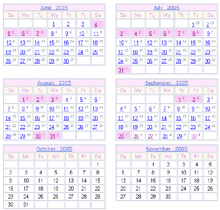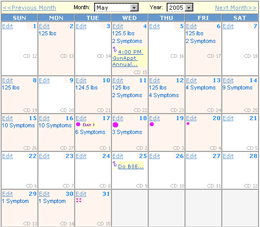Period Tracking FAQs
MyMonthlyCycles has two versions of its menstrual cycle calendar for tracking your period: Period Calendar, just for tracking your periods; And, the Menstrual Calendar, for completely tracking your menstrual cycles, including your menstrual and PMS symptoms, BBT, breast exams, weight, and more.
The Period Calendar (shown above) version is ideal if you're just starting out with MyMonthlyCycles and want to quickly add your menstrual cycle history. Or, if you just want to track your period and have your average cycle length automatically calculated for use on other MyMonthlyCycles tools (such as our menstrual calculator, ovulation calculator, or the many menstrual and fertility reminders), or to take to your doctor, this is your tool!
When you want to do more, like track everything about your period (flow characteristics, cycle symptoms such as cramps, water retention, mood changes) and other events in your monthly cycle, then it's time to switch your view to the Menstrual Calendar (shown above).
This FAQ provides info for tracking your period using our Period Tracker Calendar. If it applies to both calendars, you'll see a note Applies to both.
How do I Navigate the Period Calendar?

The sample above shows a sample of the navigational controls available. (Note: sample is not clickable!).
You can view 1 month, 3 month, 6 months, or 1 year. Just click on the number of months you want displayed and your view will be updated.
The month and year in the drop-down boxes control which month(s) are displayed (either as the only month, if 1 month is selected, or as the first month if multiple months are selected). You can switch which month(s) are displayed in any of the following ways:
- Change the month or the year in the drop-down boxes and click the Go button.
- Use the next or previous links, to move one month forward or backward. These links become unavailable when you reach the calendar's date range limit
- Click on Today Is... to move the calendar to the current month and year.
Applies to Both Menstrual Calendars: You can not track your period beyond the current date.
How do I switch between Period Calendar and Menstrual/Fertility Calendar?
 From Period Calendar to Menstrual Calendar: At the top of each month's calendar,
the month and year
is a link. Click on that link, and you'll go direct to the menstrual calendar
for the same month and year! Switching to our main menstrual cycle calendar
will offer you many more tracking options, as noted earlier.
From Period Calendar to Menstrual Calendar: At the top of each month's calendar,
the month and year
is a link. Click on that link, and you'll go direct to the menstrual calendar
for the same month and year! Switching to our main menstrual cycle calendar
will offer you many more tracking options, as noted earlier.
From Menstrual Calendar to Period Calendar: On the Cycle Taskbar, click on Period Calendar.
How do I Track My Period?
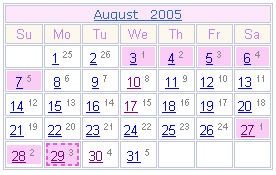 Adding Period Day - To add your period to the calendar, simply click on that day's link within
the calendar. For example, if you had your period on August 29, 2005, click on the 29
within the August, 2005 calendar.
Adding Period Day - To add your period to the calendar, simply click on that day's link within
the calendar. For example, if you had your period on August 29, 2005, click on the 29
within the August, 2005 calendar.
Deleting Period Day - If you accidentally added your period on the wrong day, you can easily delete it by clicking on that date cell again. That day of your period is removed from your menstrual calendar.
What Notations/Colors are used on the Period Calendar?
 Period Day
Period Day
 Period Day just added. Dotted border is used to highlight the calendar date where you just clicked.
Period Day just added. Dotted border is used to highlight the calendar date where you just clicked.
 Period Day just deleted. Dotted border highlights the calendar date you just clicked.
Period Day just deleted. Dotted border highlights the calendar date you just clicked.
What Flow Level is stored when I track my period?
When you use Period Calendar , the flow level for each day of your period defaults to Medium. To track more about your period, including flow level (light, medium, or heavy), clots, and notes, you need to switch to our other menstrual calendar.
Of course, if your primary goal is just to keep track of your periods, or build up past history, where you might not have a manual record of flow level, you can leave the default flow level as is.
Does the calendar know which is the first day of my period?
Yes. When you add a period day to your menstrual calendar, MyMonthlyCycles will automatically determine if this is the first day of your menstrual cycle. It does so by looking at adjacent slots on your calendar. For this reason, it's essential that you either track just the first day of each of your period, or all days of your period. More on this below!
Why do some date cells have a light colored number in them?

It's your Cycle Day!After you track the first day of a period, you'll notice that the date cells for that period day, and subsequent ones, change. These date cells will have a light colored number to the right of the date, elevated slightly. This is your cycle day.
Starting with the first day of your period, which is cycle day 1, cycle day increases by 1 up until the first day of your next period. The first day of your next period then becomes 1 again.
In the sample just above, the period starting on Sept. 3rd is Cycle Day 1. Notice how the cycle day increases by 1 up to the start of the next period on Sept 27th, which again becomes cycle day 1.
Applies to both menstrual calendars.
What is Cycle Day?
As you know, there's a difference between your menstrual period and your menstrual cycle. Your menstrual period pertains to the days in your cycle when you menstruate. Your menstrual cycle spans from the first day of your period to the day before your next period starts. In essense, menstrual cycle is the bigger picture, everything that goes on throughout your cycle (menstruation, menstrual symptoms, PMS symptoms, hormonal changes, ovulation, etc.), and your period is the event that marks the start of each new menstrual cycle.
In the sample above, the menstrual period starting August 3rd lasted for 5 days. The start date of the next period is August 27th. So the cycle starting August 3rd has a menstrual cycle length of 24 days (Aug 3 - Aug 26), and if you look at the cycle day count, that's exactly what it shows!
The period calendar shows your cycle days, a great way to see where you are in your current cycle, and the cycle length of each of your previous cycles.
Applies to Both Menstrual Calendars
Some date cells don't show a cycle day. Why not?
Cycle day will not be shown prior to the very first period you track in MyMonthlyCycles. After you add your first period, cycle day will show for that period up to the current date. As noted in the last section, cycle day adjusts itself based on the first day of the periods you track. The first day of your period is always cycle day 1. The maximum cycle day that the calendar will display is 600. If a cycle is longer than 600 days, a red * (asterisk) is displayed instead of the cycle day.
Applies to both menstrual calendars.
The cycle day counter is much larger than my normal cycle length? Why?
There are a few reasons this could occur. Is this the "cycle" where you were pregnant? That is, you had recorded your last period before you became pregnant, and then recorded the next period, which occurred after your baby was born. If so, that's the reason for the long cycle length and the large cycle day numbers.
Or, did you track a period way in the past, and the next period you tracked was much more recent? This could occur due to accidental data entry (you added your period to the wrong month/year), or you planned to track past periods but moved to the present before you filled in the intervening months.
If the problem is due to data entry, you can easily find the aberrant period! Simply set your view to 12 months, and then page backward, preferably using the month/year drop-down to navigate, until you see cycle day 1.
See also: Cycle lengths that are longer (or shorter) than usual will affect your average cycle length. To easily resolve, refer to MyMonthlyCycles Tracking Tips document.
Applies to both menstrual calendars.
Can I track just the first day and last day of my period?
Applies to both menstrual calendars.
No! But let us clarify this. The calendar will let you track the first and last day of your period. But don't! We can not emphasize this enough when we say: you should either track just the first day of your period; Or, track all days of your period.
Of course, you can vary this for each period, but this rule always applies. When you track a given period, track just the first day, or track every day of your period. Avoid leaving gaps (non-tracked days) between the first and last day of your period.
And why? Because: MyMonthlyCycles automatically calculates your average cycle length for you. And that's really useful since many other MyMonthlyCycles tools will then use your average cycle length, such as when forecasting your future periods, or when sending a menstrual reminder that your period is about to start or may be late. If your average cycle length is wrong, the tools will not perform optimally for you.
Because MyMonthlyCycles auto-detects the first day of your period, if you only track your first day and last day, it will determine that both your first day and your last day are day 1 of your period. And that will result in a very short cycle. And, since it becomes part of your average cycle length, that, in turn, will be incorrect.
Period Tracking Example: Let's track a period which started on July 8th and Ended on July 12th. We'll show the wrong way, and two right ways to do this!
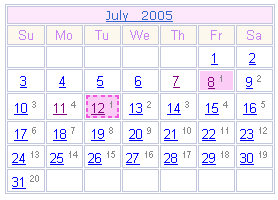
The wrong way to track: Add period days for July 8th and July 12th.
In fact, were you to do this (and we know you won't!), you'd see what's shown on the sample at right: the cycle day number for July 8th and July 12th are 1. Also, July 11th shows cycle day 4 - and that's key to the problem. Because July 12th is assumed to be a new period, the cycle corresponding to the period starting on July 8th has a cycle length of just 4 days. And that's definitely not correct.
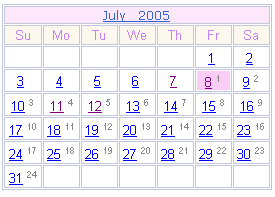
The right way - Option 1: Track just the first day of your period, in this example just July 8th, by clicking on the July 8th date cell.
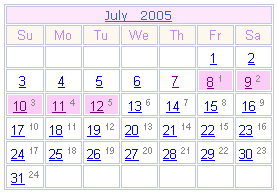
The right way - Option 2: Track all days of your period, in this example July 8, 9, 10, 11, 12. That is, click on each date cell to track each day of this period.
Notice how the cycle days properly increment in both of these examples where either just the first day is tracked, or all days are tracked.



